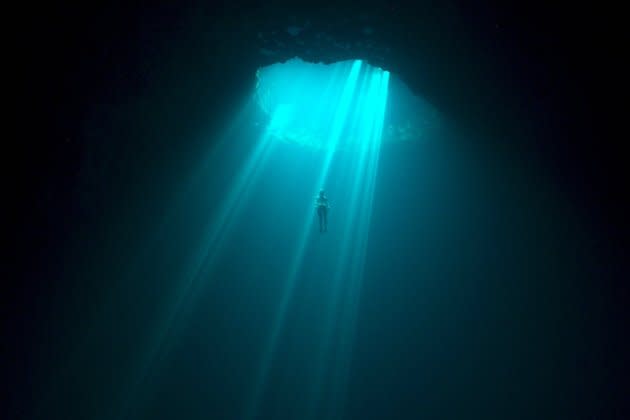‘The Deepest Breath’: Netflix’s Dangerous Doc About Freedivers
- Oops!Something went wrong.Please try again later.
- Oops!Something went wrong.Please try again later.

It doesn’t take long for the new Netflix/A24 documentary The Deepest Breath to let you know an ill wind is blowing. “I accepted that she was doing a dangerous thing,” intones the father of Alessia Zecchini, one of the world’s elite freedivers. “Extreme sports have extreme consequences,” says the father of safety diver Stephen Keenan. Both parents have funereal looks on their faces as they speak. Zecchini and Keenan, the documentary’s principal characters, appear only in previously shot footage. The question isn’t if someone will die here, but who, when and how. This is the gist of the film’s storytelling strategy, and for the most part it works. It keeps you wondering what fate will befall these intertwined figures who live seemingly to cheat death, and it manages to celebrate the depths to which they pursued their shared obsession.
Their chosen sport could scarcely be more dangerous. Freedivers descend beneath water’s surface to extreme depths, powered only by the single breath they take before their downward journey. Blackouts are not uncommon: the diver’s brain, starved for oxygen, shuts down; he or she is then fished to the surface, eyes rolling toward the back of the head, as medical staff sets to the work of reviving. Then there’s the lung bleed, also potentially fatal, which is about as bad as it sounds. As The Deepest Breath begins, Zecchini, an Italian woman with a full-bore approach to everything, is asked a blunt question: “How do you feel about death?” The query lingers over the rest of the film, which, it turns out, is actually a love story.
More from Rolling Stone
The Open Livestream: How to Watch the Golf Tournament Online
Women's World Cup Livestream: How to Watch the FIFA Soccer Tournament Online for Free
Comedian Tom Segura Wants to Know Where the Bodies Are, Garth Brooks
Zecchini’s counterpart is Keenan, an Irishman with twinkling blue eyes. As a young man he became enchanted with a photo of a Congolese gorilla in National Geographic and decided he needed to explore Africa, which he did at length. He, too, was drawn to freediving, eventually becoming a crackerjack rescue driver, assigned to guide and, if necessary, save imperiled divers. He begins training Zecchini, and we essentially watch as they fall in love, looking at each other in a way that needs no words to explain.
Director Laura McGann benefits from a treasure chest of footage that accentuates her protagonists’ personalities and opens up underwater sensations that most of us are content to never experience. It can get dark down there; as Zecchini puts it, “It’s like being in the last quiet place on Earth.” As we watch the divers go down, down, down, then face the pressure of coming back up, it’s hard not to hold our collective breath a little as well. That The Deepest Breath will be streaming is a shame; its visual scope and impact cry out for a big-screen experience.
The Deepest Breath film opens with a disclaimer, letting us know that it blends archive material and reenactments with footage shot during competitions, but this feels less like cheating than creative accenting. The end result is what’s important; the film seamlessly creates an otherworldly and undeniably dangerous world that is somehow peaceful as well. It also captures something of the subculture that is the freediving world, made up of intensely driven people who know their passion could spell their end at any time. Zecchini in particular swims right up to the edge of recklessness, doggedly pursuing world records, which tend to hover just north of 100 meters, with a determination that seems to frustrate and frighten some in her circle. In this world, no one can be surprised when one’s heroes, peers, and friends perish. The survivors mourn, they hold an underwater vigil, and they dive again. When you live to cheat death, there’s a decent chance you will, in fact, die. Then again, we all do that eventually, most in more quotidian fashion.
How you feel about The Deepest Breath may ultimately come down to how you respond to its structure, which leans heavily on withheld information. Throughout its nearly two-hour running time, the film moves toward something inexorable. Zecchini and Keenan will not emerge together, smiling for the cameras. The line between suspense and manipulation can be mighty fine. But The Deepest Breath walks it well. The filmmakers know they have a good story on their hands, and they shape it with sensitivity to the star-crossed divers and to the viewer. In the end it is well worth the plunge.
Best of Rolling Stone
